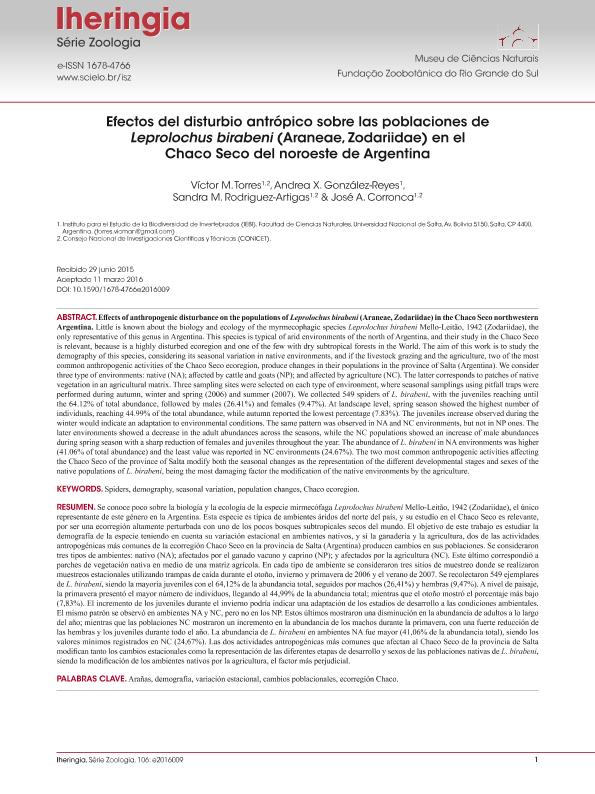Artículo
Se conoce poco sobre la biología y la ecología de la especie mirmecófaga Leprolochus birabeni Mello-Leitão, 1942 (Zodariidae), el único representante de este género en la Argentina. Esta especie es típica de ambientes áridos del norte del país, y su estudio en el Chaco Seco es relevante, por ser una ecorregión altamente perturbada con uno de los pocos bosques subtropicales secos del mundo. El objetivo de este trabajo es estudiar la demografía de la especie teniendo en cuenta su variación estacional en ambientes nativos, y sí la ganadería y la agricultura, dos de las actividades antropogénicas más comunes de la ecorregión Chaco Seco en la provincia de Salta (Argentina) producen cambios en sus poblaciones. Se consideraron tres tipos de ambientes: nativo (NA); afectados por el ganado vacuno y caprino (NP); y afectados por la agricultura (NC). Este último correspondió a parches de vegetación nativa en medio de una matriz agrícola. En cada tipo de ambiente se consideraron tres sitios de muestreo donde se realizaron muestreos estacionales utilizando trampas de caída durante el otoño, invierno y primavera de 2006 y el verano de 2007. Se recolectaron 549 ejemplares de L. birabeni, siendo la mayoría juveniles con el 64,12% de la abundancia total, seguidos por machos (26,41%) y hembras (9,47%). A nivel de paisaje, la primavera presentó el mayor número de individuos, llegando al 44,99% de la abundancia total; mientras que el otoño mostró el porcentaje más bajo (7,83%). El incremento de los juveniles durante el invierno podría indicar una adaptación de los estadios de desarrollo a las condiciones ambientales. El mismo patrón se observó en ambientes NA y NC, pero no en los NP. Estos últimos mostraron una disminución en la abundancia de adultos a lo largo del año; mientras que las poblaciones NC mostraron un incremento en la abundancia de los machos durante la primavera, con una fuerte reducción de las hembras y los juveniles durante todo el año. La abundancia de L. birabeni en ambientes NA fue mayor (41,06% de la abundancia total), siendo los valores mínimos registrados en NC (24,67%). Las dos actividades antropogénicas más comunes que afectan al Chaco Seco de la provincia de Salta modifi can tanto los cambios estacionales como la representación de las diferentes etapas de desarrollo y sexos de las poblaciones nativas de L. birabeni, siendo la modifi cación de los ambientes nativos por la agricultura, el factor más perjudicial. Little is known about the biology and ecology of the myrmecophagic species Leprolochus birabeni Mello-Leitão, 1942 (Zodariidae), the only representative of this genus in Argentina. This species is typical of arid environments of the north of Argentina, and their study in the Chaco Seco is relevant, because is a highly disturbed ecoregion and one of the few with dry subtropical forests in the World. The aim of this work is to study the demography of this species, considering its seasonal variation in native environments, and if the livestock grazing and the agriculture, two of the most common anthropogenic activities of the Chaco Seco ecoregion, produce changes in their populations in the province of Salta (Argentina). We consider three type of environments: native (NA); aff ected by cattle and goats (NP); and aff ected by agriculture (NC). The latter corresponds to patches of native vegetation in an agricultural matrix. Three sampling sites were selected on each type of environment, where seasonal samplings using pitfall traps were performed during autumn, winter and spring (2006) and summer (2007). We collected 549 spiders of L. birabeni, with the juveniles reaching until the 64.12% of total abundance, followed by males (26.41%) and females (9.47%). At landscape level, spring season showed the highest number of individuals, reaching 44.99% of the total abundance, while autumn reported the lowest percentage (7.83%). The juveniles increase observed during the winter would indicate an adaptation to environmental conditions. The same pattern was observed in NA and NC environments, but not in NP ones. The later environments showed a decrease in the adult abundances across the seasons, while the NC populations showed an increase of male abundances during spring season with a sharp reduction of females and juveniles throughout the year. The abundance of L. birabeni in NA environments was higher (41.06% of total abundance) and the least value was reported in NC environments (24.67%). The two most common anthropogenic activities aff ecting the Chaco Seco of the province of Salta modify both the seasonal changes as the representation of the diff erent developmental stages and sexes of the native populations of L. birabeni, being the most damaging factor the modifi cation of the native environments by the agriculture.
Efectos del disturbio antrópico sobre las poblaciones de Leprolochus birabeni (Araneae, Zodariidae) en el Chaco Seco del noroeste de Argentina
Título:
Effects of anthropogenic disturbance on the populations of leprolochus birabeni (Araneae, Zodariidae) in the Chaco Seco Northwestern Argentina
Torres, Victor Manuel ; González Reyes, Andrea Ximena; Rodriguez Artigas, Sandra Mónica
; González Reyes, Andrea Ximena; Rodriguez Artigas, Sandra Mónica ; Corronca, Jose Antonio
; Corronca, Jose Antonio
 ; González Reyes, Andrea Ximena; Rodriguez Artigas, Sandra Mónica
; González Reyes, Andrea Ximena; Rodriguez Artigas, Sandra Mónica ; Corronca, Jose Antonio
; Corronca, Jose Antonio
Fecha de publicación:
07/2016
Editorial:
Fundaçao Zoobotanica Rio Grande Sul
Revista:
Iheringia. Série Zoologia
ISSN:
0073-4721
e-ISSN:
1678-4766
Idioma:
Español
Tipo de recurso:
Artículo publicado
Clasificación temática:
Resumen
Archivos asociados
Licencia
Identificadores
Colecciones
Articulos(CCT - SALTA-JUJUY)
Articulos de CTRO.CIENTIFICO TECNOL.CONICET - SALTA-JUJUY
Articulos de CTRO.CIENTIFICO TECNOL.CONICET - SALTA-JUJUY
Citación
Torres, Victor Manuel; González Reyes, Andrea Ximena; Rodriguez Artigas, Sandra Mónica; Corronca, Jose Antonio; Efectos del disturbio antrópico sobre las poblaciones de Leprolochus birabeni (Araneae, Zodariidae) en el Chaco Seco del noroeste de Argentina; Fundaçao Zoobotanica Rio Grande Sul; Iheringia. Série Zoologia; 106; 7-2016; 1-8
Compartir
Altmétricas



